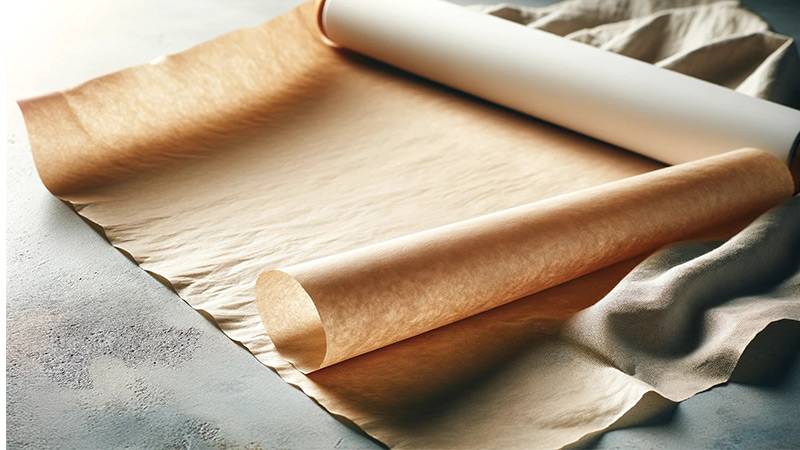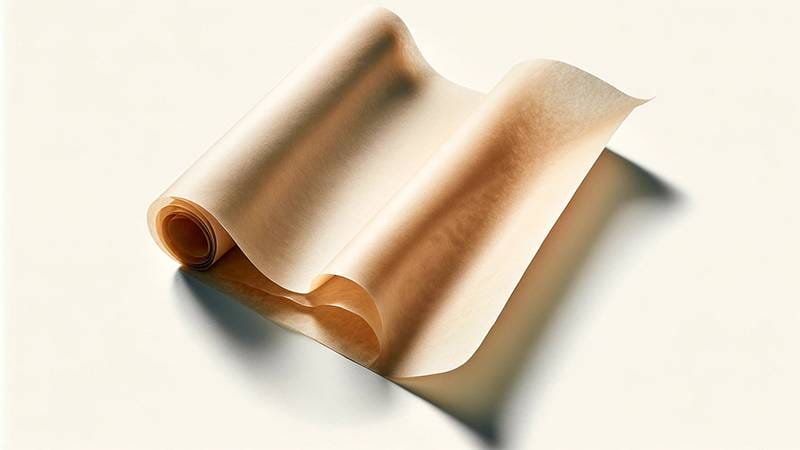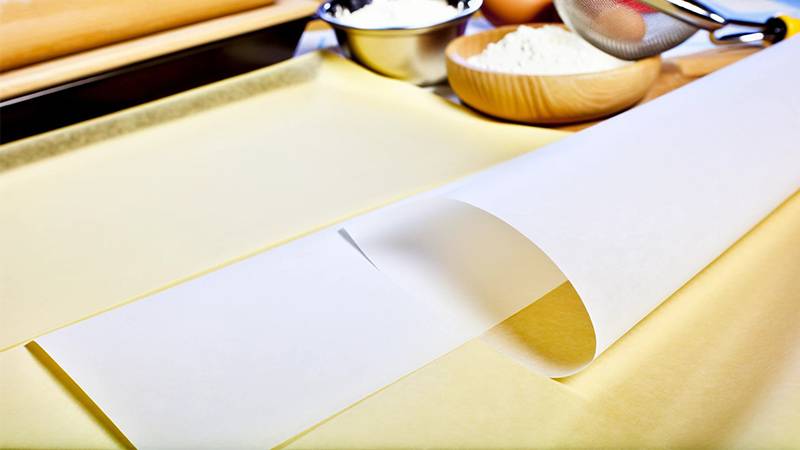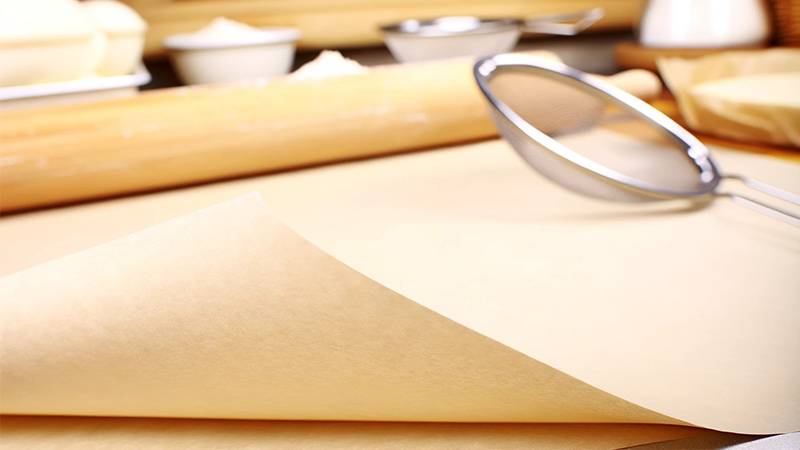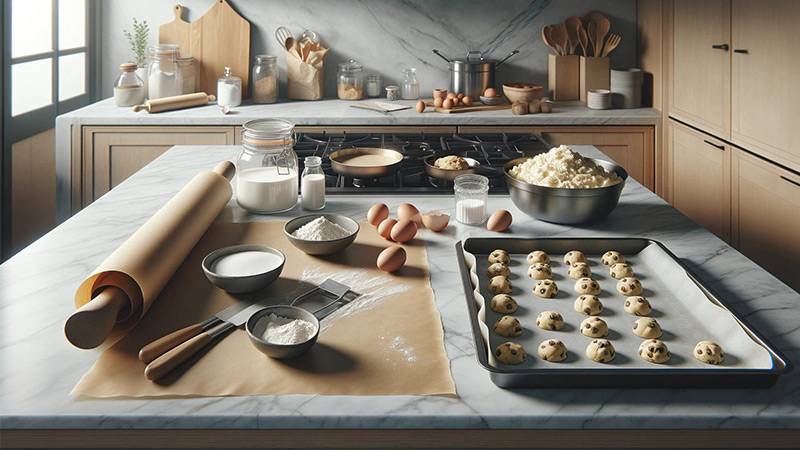In today’s eco-conscious world, the sustainability of everyday items is more scrutinized than ever. Parchment paper, a staple in kitchens worldwide, is no exception.
Many of us wonder: is parchment paper truly eco-friendly? Can it be composted, recycled, or is it simply waste?
This article dives deep into these questions, offering clear, well-researched insights into the environmental impact of parchment paper. From its compostability and biodegradability to its various uses and production process, we’ll explore everything you need to make informed choices in your kitchen. Let’s embark on this journey to greener cooking practices together.
Is Parchment Paper Compostable?
The answer is: it depends. The compostability of parchment paper hinges on several factors, including whether it is silicone-coated or uncoated. Let’s delve into the specifics to understand this better.
Uncoated parchment paper, which is less common in the market, can generally be composted. Its natural, unbleached fibers break down in a composting environment, making it a friendlier option for eco-conscious consumers. However, the more prevalent silicone-coated parchment paper complicates the matter. The silicone coating, while excellent for non-stick baking, is not biodegradable and can hinder the composting process.Experts in waste management and composting suggest that while small amounts of silicone-coated parchment paper might not significantly disrupt a large, well-managed compost heap, it’s best to limit or avoid adding it to your compost. The silicone can slow down the decomposition process, potentially introducing non-biodegradable remnants into the compost.To navigate this, some suggest ripping the paper into small pieces to aid decomposition or only composting parchment that has been certified as compostable by reputable environmental organizations. These products are designed to break down more effectively in industrial composting facilities, where higher temperatures and managed conditions help decompose materials that might not break down as easily in home composting setups.
In summary, the compostability of parchment paper varies. Uncoated versions are generally compostable, while silicone-coated ones present more of a challenge. When aiming for sustainable kitchen practices, consider seeking out specifically labeled compostable parchment paper or exploring alternative eco-friendly baking solutions. This nuanced approach ensures that our kitchen habits align with broader environmental goals, contributing to a more sustainable future.
Read More:
Are Paper Towels Compostable? What You Need to Know
Is Parchment Paper Biodegradable?
Understanding the distinction between compostable and biodegradable materials is key when considering the environmental impact of products like parchment paper. Essentially, all compostable materials are biodegradable, but not all biodegradable materials are compostable. Biodegradable items can break down and return to nature, potentially leaving behind no trace, whereas compostable materials go one step further by decomposing into nutrient-rich soil additive under the right conditions.So, is parchment paper biodegradable? The answer varies. Uncoated parchment paper, made from natural paper, typically falls into the biodegradable category because it can break down and integrate back into the environment without causing harm. However, the process and timeline for degradation depend heavily on environmental conditions and the presence of microorganisms.On the other hand, silicone-coated parchment paper presents a more complex case. While the paper base is biodegradable, the silicone coating complicates its ability to return fully to nature. Silicone is durable and resistant to breakdown, meaning that while the paper component might degrade, the silicone might persist in the environment.This distinction is crucial for eco-conscious consumers looking to minimize their environmental footprint. Opting for uncoated parchment paper can be a more sustainable choice, aligning with eco-friendly disposables and sustainable kitchen products. When selecting parchment paper, understanding its biodegradability helps in making informed decisions that support waste reduction and environmental sustainability efforts.
Read More:
Are Egg Cartons Compostable? What You Must Know
Can You Recycle Parchment Paper?
When it comes to recycling, parchment paper sits in a grey area, presenting challenges for eco-conscious individuals keen on reducing their kitchen waste. The recyclability of parchment paper is not straightforward due to its specific properties and the variety of types available on the market.Most recycling programs do not accept parchment paper, primarily because of the silicone coating found on many varieties. This coating, while beneficial for non-stick baking, complicates the recycling process. The paper fibers are coated with silicone, making it difficult to separate and process them into new paper products. Additionally, used parchment paper often contains food residues, further complicating recycling efforts.For uncoated parchment paper, the scenario is slightly different, although still problematic. While theoretically more recyclable due to the absence of silicone, the presence of food oils and residues can still render it unsuitable for recycling, as these contaminants can disrupt the paper recycling process.The best course of action for disposing of parchment paper, particularly the silicone-coated variety, is to minimize its use and seek alternative eco-friendly baking solutions when possible. For those times when parchment paper is necessary, ensure that any excess food residue is removed, and consult local waste management guidelines to see if there are any specialized recycling programs that might accept it.
Read More:
A Guide to Apartment Composting Without The Smelly Problem
What is Parchment Paper?
Parchment paper is a staple in both professional kitchens and home baking setups, prized for its non-stick properties and versatility. At its core, parchment paper is a high-density, cellulose-based paper that undergoes a special treatment process to achieve its distinctive qualities. This process typically involves running the paper through a sulfuric acid bath or coating it with silicone, which significantly alters its structure, making it resistant to grease, moisture, and high temperatures.Unlike wax paper, which is coated in paraffin wax, or aluminum foil, parchment paper’s unique treatment allows it to withstand oven temperatures up to about 450 degrees Fahrenheit without burning or melting. This makes it ideal for a wide range of uses in the kitchen, from lining baking sheets for cookies and pastries to wrapping fish and vegetables for en papillote cooking methods.The non-stick surface of parchment paper means that food releases easily after cooking, eliminating the need for additional grease and facilitating quicker cleanup. Furthermore, its ability to act as a barrier between food and cooking surfaces helps ensure even baking and prevents scorching, distinguishing it as an indispensable tool for bakers and cooks seeking precision and ease in their culinary creations.
Read More:
Everything You Need to Know About Backyard Composting
Types of Parchment Paper
Parchment paper comes in several varieties, each suited to different culinary needs and environmental considerations. The most common types are bleached, unbleached, and silicone-coated parchment paper.
Bleached Parchment Paper
Bleached parchment paper is white, having been treated with chlorine to achieve its color. This type is widely used for its aesthetic appeal, especially when a clean, white background is desired for baking tasks. However, the bleaching process raises environmental concerns due to the chemicals used, which can impact both compostability and recyclability.
Unbleached Parchment Paper
Unbleached parchment paper retains its natural, brown color as it hasn’t been treated with chlorine. This option is often preferred by eco-conscious consumers, as it’s perceived to be more environmentally friendly. Unbleached parchment paper is compostable, especially in industrial facilities, and its lack of chemical treatment makes it a slightly better option for recycling, although this is still limited by the presence of food residue.
Silicone-Coated Parchment Paper
Silicone-coated parchment paper, whether bleached or unbleached, features a non-stick surface ideal for baking. The silicone coating, while excellent for preventing sticking, complicates both composting and recycling processes. As discussed earlier, the silicone is not biodegradable, making this type less eco-friendly in terms of waste management.
How is Parchment Paper Made?
The manufacturing of parchment paper is a sophisticated process that transforms ordinary paper into a versatile, heat-resistant kitchen tool. Initially, the base paper, typically made from cellulose fibers derived from wood pulp, undergoes a rigorous treatment to enhance its durability, non-stick properties, and resistance to moisture and grease.The primary method involves running the paper through a sulfuric acid bath, which partially dissolves the cellulose fibers, causing them to gelatinize. Once neutralized, this results in a dense, tightly meshed structure that is much less permeable than regular paper. Alternatively, the paper may be coated with silicone, a synthetic polymer that provides a non-stick surface. Both processes imbue parchment paper with its characteristic features, allowing it to withstand high baking temperatures without disintegrating or catching fire.From an environmental perspective, the production of parchment paper raises certain considerations. The use of sulfuric acid and the bleaching process involved in making some types of parchment paper can have negative environmental impacts, including chemical runoff and pollution. The silicone coating process, while less chemically intensive, introduces non-biodegradable materials into the environment.Eco-conscious manufacturers may opt for less harmful production methods, such as using elemental chlorine-free (ECF) bleaching processes or sourcing silicone from more sustainable production lines. Consumers aiming for sustainable kitchen practices should look for parchment paper that is certified by environmental organizations, indicating that it meets certain standards for environmental responsibility in its production.
Uses of Parchment Paper in the Kitchen
Parchment paper’s versatility makes it an indispensable tool in the kitchen, suited for a range of cooking and baking needs. Commonly, it’s used to line baking sheets and cake pans to prevent sticking and ensure easy cleanup, ideal for baking cookies, pastries, and breads. It also serves as a protective layer for baking dishes, preventing scorching and sticking without the need for additional grease.Beyond basic baking, parchment paper is perfect for en papillote cooking, a method where food is enclosed in a parchment paper pouch and baked, steaming in its own juices. This technique not only enhances flavor but also reduces the need for added fats, aligning with healthier cooking practices.For eco-friendly practices, reusing parchment paper where possible is a sustainable choice. Though not suitable for all tasks, especially those involving raw meats, parchment can often be used multiple times for baking similar items, reducing waste. Additionally, choosing unbleached parchment paper minimizes environmental impact, as it avoids the chemical waste associated with bleaching.Innovatively, parchment can be cut into rounds for use beneath pizza dough for easy oven transfer or folded into cones for precise icing on cakes and cookies. Its heat resistance also makes it handy for crafting homemade wrappers for freezer meals, contributing to waste reduction by avoiding single-use plastics.
Conclusion
In exploring the intricacies of parchment paper—from its compostability and biodegradability to its types, uses, and production—we’ve uncovered a multifaceted kitchen tool with significant environmental implications. While it presents challenges in terms of recycling and composting, especially with silicone-coated varieties, its utility in the kitchen is undeniable.As eco-conscious consumers, it’s vital to weigh these factors, opting for the most sustainable options available, such as uncoated or certified compostable parchment paper. By making informed choices, we contribute to a more sustainable future.Let’s commit to greener cooking practices. Share this guide and help spread the word about sustainable kitchen habits.

